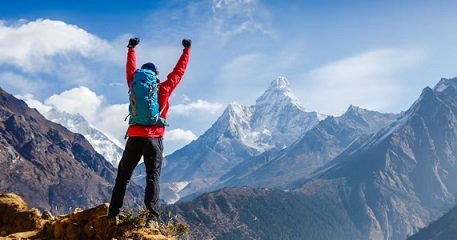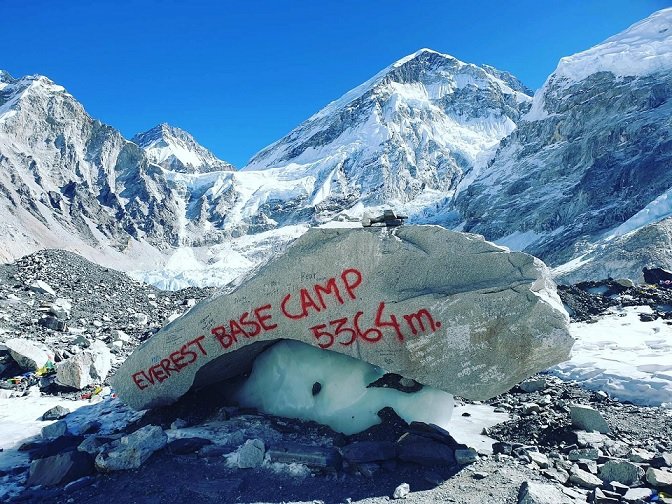Everest Base Camp Trek The Ultimate Adventure for Hiking Enthusiasts

The Everest Base Camp Trek stands as a quintessential adventure for hiking enthusiasts, embodying the spirit of exploration and the allure of the world’s highest peak. Nestled in the heart of the Himalayas, this trek offers an unparalleled journey through some of the most breathtaking landscapes on the planet. The trek typically begins in Lukla, where hikers are greeted with a thrilling flight that offers stunning views of the mountains before touching down in one of the world’s most challenging airports. From there, the trail weaves through charming Sherpa villages, where traditional stone houses and vibrant prayer flags paint a picturesque scene against the backdrop of towering peaks.
As hikers ascend, they traverse diverse terrains, from lush forests of rhododendron and pine to rocky moraine fields. The path offers panoramic views of iconic peaks like Nuptse, Lhotse, and of course, Everest, which looms majestically in the distance. Each day on the trek brings a new landscape and a fresh perspective, as the trekker’s altitude increases and the air grows thinner. The route is dotted with ancient monasteries and stupas, where the hum of prayer wheels and the scent of incense provide a spiritual connection to the land.
Acclimatization is a crucial aspect of the trek, as hikers gradually ascend to Everest Base Camp Trek Itinerary, located at an altitude of 5,364 meters. This careful progression helps the body adjust to the reduced oxygen levels, reducing the risk of altitude sickness and ensuring a more comfortable experience. Along the way, trekkers encounter various campsites and lodges, where they can rest, enjoy hearty meals, and immerse themselves in the local culture. The hospitality of the Sherpa people, with their warm smiles and deep knowledge of the mountains, adds a unique and enriching dimension to the journey.
The trek is not only a test of physical endurance but also a profound personal journey. The sense of achievement upon reaching Everest Base Camp is unparalleled, as hikers stand at the foot of the world’s highest peak, gazing up at the colossal icefall and the formidable south face of Everest. This moment is often accompanied by a profound sense of humility and awe, as trekkers reflect on the grandeur of nature and their own resilience.
Beyond the physical and emotional challenges, the Everest Base Camp Trek offers a chance to witness the changing seasons and the varied climates of the Himalayas. From the spring bloom of wildflowers to the snow-covered vistas of winter, the trek provides a dynamic and ever-changing experience. For many, the Everest Base Camp Trek is more than just a hike; it is a transformative adventure that leaves an indelible mark on the soul. It’s a journey that combines natural beauty, cultural immersion, and personal triumph, making it a dream expedition for hiking enthusiasts from around the globe.
Introduction to Everest Base Camp Trek
The Everest Base Camp Trek is renowned as one of the most iconic and exhilarating trekking experiences in the world. Situated in the Khumbu region of Nepal, this trek offers adventurers the chance to get up close to Mount Everest, the tallest peak on the planet. The journey typically begins with a thrilling flight from Kathmandu to Lukla, the gateway to the Himalayas, and continues through a series of picturesque Sherpa villages, lush forests, and high-altitude landscapes. Trekkers follow a well-trodden path that gradually ascends, allowing them to acclimatize to the thinning air while soaking in stunning views of the surrounding peaks, including Everest itself. The trek is not only a physical challenge but also a profound cultural experience, as hikers interact with the warm and hospitable Sherpa people and visit ancient monasteries along the way. Reaching Everest Base Camp, located at an altitude of 5,364 meters, offers a sense of accomplishment and a breathtaking vantage point to admire the formidable south face of Everest and the surrounding mountain grandeur. The trek combines the thrill of high-altitude adventure with the serene beauty of the Himalayas, making it a bucket-list experience for many outdoor enthusiasts.
Best Time to Trek
Choosing the Best time for the Everest Base Camp Trek is crucial for ensuring a safe and enjoyable experience. The trek is most commonly undertaken during the pre-monsoon (spring) and post-monsoon (autumn) seasons. Spring, from late March to May, is the peak trekking season due to stable weather conditions, clear skies, and moderate temperatures. This period offers trekkers the best views of Everest and the surrounding peaks, with blooming rhododendrons adding color to the landscape. Conversely, autumn, from late September to early November, also presents favorable conditions with crisp weather, clear skies, and fewer trekkers compared to spring. Both seasons offer excellent visibility and relatively stable weather, although temperatures can drop significantly at higher altitudes. The monsoon season, from June to August, is generally avoided due to heavy rains and increased risk of landslides, while winter, from December to February, brings extreme cold and snow, making trekking more challenging. Ultimately, spring and autumn are the ideal times to embark on the Everest Base Camp Trek, balancing pleasant weather with clear views and manageable conditions.
Preparation and Training
Preparation and training are essential for successfully completing the Everest Base Camp Trek, given the physical demands and high-altitude environment. A well-structured fitness regimen is crucial; potential trekkers should engage in cardiovascular exercises, such as running, cycling, or swimming, to build stamina and endurance. Incorporating strength training, particularly for the legs and core, helps in handling the varied terrain of the trek. It’s also beneficial to practice hiking with a weighted backpack to simulate the conditions of the trek. Beyond physical fitness, acclimatization plays a critical role in reducing the risk of altitude sickness. Trekkers should consider completing shorter high-altitude hikes prior to the Everest Base Camp Trek to prepare their bodies for reduced oxygen levels. Additionally, mental preparation is important as the trek involves long days of walking and can be physically and emotionally challenging. Familiarizing oneself with the trek’s itinerary, potential challenges, and safety protocols ensures a well-rounded approach to preparation. Consulting with a trekking agency for guidance on logistics, health considerations, and necessary permits can further enhance the preparation process. A comprehensive training plan and thorough preparation increase the likelihood of a safe and rewarding trekking experience in the Himalayas.
Choosing a Trekking Route
Choosing the right trekking route for the Everest Base Camp Trek involves several considerations to ensure an optimal experience. The classic route starts from Lukla and follows the well-established trail through Namche Bazaar, Tengboche, Dingboche, and Lobuche before reaching Everest Base Camp. This traditional route provides ample opportunities for acclimatization and cultural experiences, including visits to Sherpa villages and monasteries. For those seeking a more leisurely experience or additional acclimatization days, variations like the Everest Base Camp with Gokyo Lakes trek offer a circuit that includes visits to the stunning Gokyo Lakes and viewpoints such as Gokyo Ri. This extended route provides diverse scenic experiences and a broader perspective of the Khumbu region. Alternatively, the Everest Base Camp via the Three Passes trek is a challenging option that includes crossing high mountain passes like Kongma La, Cho La, and Renjo La, offering more rugged terrain and panoramic views. This route is ideal for experienced trekkers looking for a more strenuous adventure. Each route has its own unique advantages, so choosing one depends on factors such as fitness level, time available, and the desire for additional scenic or cultural experiences. Consulting with trekking agencies and reviewing detailed route descriptions can help trekkers select the option that best aligns with their goals and preferences.
Essential Gear and Equipment
Proper gear and equipment are crucial for a successful and comfortable Everest Base Camp Trek, given the demanding conditions of high-altitude trekking. Essential items include a high-quality trekking backpack, preferably with a capacity of 50-65 liters, to carry personal belongings and necessary gear. Sturdy, well-fitted trekking boots with good ankle support and traction are vital for navigating varied terrain and ensuring stability. Clothing should be layered to adapt to fluctuating temperatures, including moisture-wicking base layers, insulating mid-layers, and a waterproof and windproof outer shell. A good quality sleeping bag rated for temperatures as low as -15°C (5°F) is important for staying warm in high-altitude lodges. Trekking poles can provide extra support and balance, especially on steep or uneven trails. Additionally, a high-altitude trek requires adequate protection from the sun, so a wide-brimmed hat, UV-blocking sunglasses, and sunscreen are essential. Hydration is crucial, so carrying a durable water bottle or hydration system, along with water purification tablets, ensures safe drinking water. A personal first-aid kit, including medications for altitude sickness, is also advisable. Investing in quality gear tailored to the trek’s demands enhances safety, comfort, and overall enjoyment, making it an integral part of the trekking preparation process.
Altitude Sickness and Safety Tips
Altitude sickness, or acute mountain sickness (AMS), is a critical concern during the Everest Base Camp Trek due to the high elevations trekkers encounter. Symptoms can range from mild headaches and dizziness to severe nausea and breathlessness. To mitigate these risks, gradual acclimatization is essential. This involves ascending slowly and allowing time for the body to adjust to decreasing oxygen levels. A common recommendation is to avoid ascending more than 300-500 meters per day above 3,000 meters and incorporating rest days at higher altitudes to aid acclimatization.
Hydration plays a key role in preventing altitude sickness, so trekkers should drink plenty of water. It’s also advisable to consume a balanced diet rich in carbohydrates to provide energy. Recognizing symptoms early and responding promptly can prevent serious complications. If symptoms persist or worsen, it’s important to descend to a lower altitude immediately and seek medical attention.
Trekking with a guide or joining a well-organized trekking group enhances safety, as experienced guides are adept at managing altitude sickness and ensuring proper acclimatization. Additionally, carrying a basic first-aid kit and necessary medications, such as acetazolamide (Diamox) for altitude sickness, can be beneficial. Ensuring that your trek includes emergency evacuation plans and insurance coverage for high-altitude trekking adds an extra layer of security. Following these safety tips will help ensure a safe and enjoyable Everest Base Camp experience.
Daily Itinerary Overview
The Everest Base Camp Trek typically unfolds over 12 to 16 days, with each day meticulously planned to balance trekking and acclimatization. The journey begins with a flight from Kathmandu to Lukla, where the adventure starts. The first few days involve trekking through lush forests and picturesque villages, such as Phakding and Namche Bazaar, with acclimatization days in Namche to explore the surrounding areas and adjust to the altitude.
Subsequent days involve ascending through Tengboche, known for its stunning monastery and views of Everest, and continuing through Dingboche, where another acclimatization day allows trekkers to adapt to higher elevations. The trek continues through Lobuche, where the landscape becomes more rugged and barren. After crossing the challenging Khumbu Glacier, trekkers finally reach Everest Base Camp, where they can marvel at the majestic south face of Everest.
The return journey retraces the route, often with quicker descents. Each day’s trek is designed to balance the physical demands with adequate rest and acclimatization, ensuring trekkers are well-prepared for the challenges of high-altitude trekking.
Highlights of the Trek
The Everest Base Camp Trek is a treasure trove of breathtaking highlights that captivate trekkers from start to finish. One of the most stunning aspects of the trek is the unparalleled views of the world’s highest peak, Mount Everest, visible from various vantage points along the route. Trekkers experience awe-inspiring vistas of other towering Himalayan giants, including Lhotse, Nuptse, and Makalu.
A significant highlight is the vibrant and bustling Namche Bazaar, the cultural and economic hub of the Khumbu region. This Sherpa town offers an introduction to local customs, markets, and incredible panoramic views of the surrounding peaks. The trek also passes through Tengboche, renowned for its monastery perched against a dramatic mountain backdrop, offering both spiritual solace and stunning views.
Reaching Everest Base Camp Expedition itself is a monumental achievement, providing trekkers with a unique vantage point to witness the majestic Khumbu Icefall and the base of the world’s highest mountain. Additionally, the trek offers opportunities to visit the scenic Gokyo Lakes or tackle high-altitude passes for those seeking extended routes. The combination of striking landscapes, cultural encounters, and personal achievement makes the Everest Base Camp Trek an unforgettable adventure.
Cultural Insights and Local Communities
The Everest Base Camp Trek provides a rich tapestry of cultural experiences through its interactions with the local Sherpa communities and their traditions. Sherpas, renowned for their mountaineering expertise, are the heart of the Khumbu region. Their warm hospitality, vibrant festivals, and traditional customs offer trekkers an authentic glimpse into Himalayan life.
Along the trek, visitors pass through several Sherpa villages, each with its own unique charm and cultural significance. Namche Bazaar, often considered the gateway to the Himalayas, is not only a bustling market town but also a cultural melting pot where trekkers can observe traditional Sherpa architecture and lifestyle. Tengboche, home to a prominent Buddhist monastery, offers insights into Tibetan Buddhism and the spiritual practices of the Sherpa people. The monastery’s prayer flags, intricate murals, and serene ambiance create a deeply spiritual experience.
Trekkers may also witness traditional festivals, such as the colorful Mani Rimdu, which celebrates the Tibetan New Year with dances, rituals, and communal feasts. Engaging with the local people, sampling traditional cuisine, and participating in cultural activities enrich the trekking experience, providing a deeper understanding of the region’s heritage and the lives of its people.
Accommodations and Facilities
Accommodations on the Everest Base Camp Trek vary from simple lodges to more comfortable guesthouses, catering to different preferences and budgets. The standard lodges, known as teahouses, offer basic amenities including a bed, blankets, and communal dining areas. While facilities are modest, they provide a warm and welcoming environment with the chance to interact with fellow trekkers.
In the lower regions of the trek, lodges are relatively comfortable, with private rooms and western-style toilets available in some places. As the trek ascends, accommodations become more basic, with shared rooms and squat toilets common in higher altitudes. Some teahouses may offer heated common rooms where trekkers can relax and socialize.
The higher the altitude, the more rudimentary the facilities, but the teahouses are generally equipped with essential services such as hot meals, tea, and snacks. Some lodges offer charging facilities for electronic devices, though power sources can be limited. Trekking groups typically plan meals and accommodations in advance, ensuring that trekkers have a comfortable and safe place to stay each night. Despite the basic nature of the facilities, the warm hospitality and the sense of community in the lodges contribute to a memorable trekking experience.
Photography Tips for the Trek
Capturing the breathtaking beauty of the Everest Base Camp Trek requires a blend of technical skills and a keen eye for the right moments. One of the most important tips is to be prepared for changing lighting conditions. Early mornings and late afternoons offer the best light, with the golden hours providing soft, warm tones that enhance landscape photos. Carrying a lens with a wide aperture can help in low-light conditions, while a zoom lens is valuable for capturing distant mountain peaks.
To ensure sharp, high-quality images, use a tripod, especially in low light or when taking long exposure shots of the night sky. This is particularly useful for capturing the majestic sunrise over Everest or the star-filled sky above the Khumbu Glacier. Pay attention to composition by incorporating leading lines, such as trails or rivers, to guide the viewer’s eye through the scene. Including local elements, such as prayer flags or traditional Sherpa houses, adds cultural context to your photos.
Be mindful of altitude and battery life; batteries tend to drain faster in cold temperatures, so keep spares warm and close to your body. Respect the environment and local customs by avoiding intrusive photography, particularly in sacred or culturally sensitive areas. Finally, take time to enjoy the experience and capture the moments that resonate with you, as personal memories often make the most meaningful photographs.
Environmental Considerations
The Everest Base Camp Trek Cost offers stunning natural beauty, but it also presents environmental challenges that require careful consideration. As one of the most popular trekking routes in the world, the area faces issues related to waste management and preservation of its fragile ecosystems. Trekkers should practice Leave No Trace principles, which involve packing out all waste, including used tissues and food scraps, to minimize environmental impact.
Plastic waste is a significant concern, so it’s advisable to use reusable water bottles and containers. Some trekking agencies provide eco-friendly alternatives, such as water purification systems, to reduce reliance on single-use plastics. Additionally, respecting local flora and fauna by sticking to marked trails helps protect delicate alpine vegetation and wildlife.
The impact of climate change is also evident in the Himalayas, with glaciers retreating and weather patterns shifting. Trekkers should stay informed about local environmental issues and support initiatives aimed at preserving the region. Engaging with local conservation efforts and following guidelines set by trekking agencies can contribute to the protection of this pristine environment for future generations.
Trekking Permits and Regulations
Trekking to Everest Base Camp requires obtaining several permits and adhering to local regulations to ensure a smooth and lawful journey. The most essential permit is the TIMS (Trekkers’ Information Management System) card, which helps track trekkers’ movements and provides safety and support in emergencies. Additionally, a Sagarmatha National Park entry permit is required, as the trek passes through this protected area, which is home to unique wildlife and natural features.
Permits can be obtained through trekking agencies or directly from relevant offices in Kathmandu or Lukla. It’s important to ensure all paperwork is completed before starting the trek to avoid delays or complications. Regulations also include guidelines for responsible trekking, such as respecting local customs, maintaining a clean trail, and following established routes.
Travel insurance that covers high-altitude trekking is strongly recommended, as it provides financial protection in case of medical emergencies or evacuation. Staying informed about any changes in permit requirements or regulations through local trekking authorities or agencies helps ensure compliance and a trouble-free trekking experience.
Recommended Guides and Tours
Choosing the right guide or tour operator is crucial for a successful Everest Base Camp Trek. Reputable guides and tour companies enhance the trekking experience through their expertise, local knowledge, and support. Look for operators with positive reviews, strong safety records, and experienced local guides who are familiar with the terrain and cultural nuances of the region.
Several well-regarded trekking companies offer packages that include comprehensive services such as permits, accommodations, meals, and experienced guides. Companies like Adventure Consultants, Intrepid Travel, and G Adventures are known for their professionalism and quality service. Local operators, such as Himalayan Glacier Trekking and Nepal Trekking, also provide personalized experiences with a focus on local expertise.
When selecting a guide or tour, consider factors such as group size, itinerary flexibility, and the level of support provided. Some companies offer private or small-group treks for a more customized experience. Ensuring that the guide is well-versed in altitude sickness management and emergency procedures is essential for safety. Investing in a reputable guide or tour ensures a well-organized trek, enhancing both safety and enjoyment.
Conclusion and Final Thoughts
The Everest Base Camp Trek stands as a pinnacle of adventure travel, offering a unique blend of challenging terrain, stunning landscapes, and rich cultural experiences. From the moment you embark on this journey, you are immersed in the awe-inspiring beauty of the Himalayas, where every step brings you closer to the world’s highest peak. The trek demands physical endurance and mental resilience, but the rewards are unparalleled—breathtaking views, a profound sense of achievement, and the opportunity to connect with the vibrant Sherpa culture.
Preparation is key to a successful trek, with careful attention to physical training, gear, and safety protocols essential for handling the high-altitude environment. Respect for the environment and local regulations ensures that the pristine beauty of the region is preserved for future adventurers. By choosing a reputable guide or tour operator, trekkers can navigate the journey with confidence, supported by local expertise and a well-organized itinerary.
Ultimately, the Everest Base Camp Trek is more than just a physical challenge; it is a journey of discovery, personal growth, and a deep appreciation for the natural world. It leaves an indelible mark on those who undertake it, providing memories and experiences that last a lifetime. Whether you are drawn by the allure of Everest, the rich cultural heritage, or the challenge of high-altitude trekking, the Everest Base Camp Trek offers an adventure of a lifetime.














